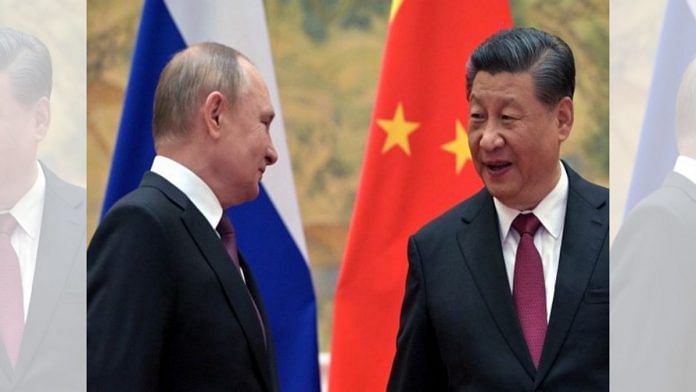New Delhi: Western sanctions on the sale of arms equipment, spare parts and components are not only affecting Russia’s arms manufacturing but their spillover effects are also being seen in countries like Myanmar.
The JF-17 aircraft — a lightweight, single-engine, multi-role combat aircraft, jointly manufactured by Pakistan Aeronautical Complex and the Chengdu Aircraft Corporation of China — inducted by Nyapidaw in 2018 have been grounded due to technical difficulties, a report on the news website The Irrawaddy suggests.
The report adds that a critical shortage of western-supplied spare parts, specifically for avionics, due to Western sanctions after the military coup in 2021 has grounded the entire fleet of JF-17s. Further, Myanmar’s air force is also unable to purchase missiles and bombs due to the sanctions.
“Essentially, this shows that the western sanctions regime is clearly working,” Avinash Paliwal, associate professor of international relations at the School of Oriental and African Studies (SOAS) London told ThePrint.
However, this doesn’t mean that Myanmar’s JF-17 fleet will be grounded forever. Technicians from China or Pakistan will probably be roped in to fix the problems soon, he said.
“In the long run, these sanctions on Russia can create an opportunity for China to supply arms instead, especially to countries like Myanmar that are heavily dependent on Russian arms,” he added.
Also read: ‘Poor Ukraine’: Sanctions on Russia hurt West too but here’s why it’s unlikely to back down
Opportunity for China & a new struggle
As author Bertil Lintner explained earlier this year, given Ukraine and Russia are Myanmar’s biggest arms suppliers, the ongoing war would diminish arms sales to the country from these sources.
Data from the Stockholm International Peace Research Institute (SIPRI) suggests that Myanmar purchased arms worth $1.7 billion from 2001 to 2021. In 2018, Myanmar agreed to buy 6 Su-30 fighter jets from Russia.
“China is looking at the arms export embargoes on Russia as an opportunity for their arms industry. Beijing would want to replace Russian arms sales with their products instead,” said Paliwal.
Reports suggest that China has been propping up Pakistan to send arms supplies to Myanmar to compensate for the lack of supplies from Russia. Wary of sanctions, China is using this route as it does not want to lose out on the Burmese market to Moscow.
A new struggle over arms supplies to countries that are impacted by the western sanctions will play out over the following years — China and Russia will be central to this — as we see in Myanmar, Paliwal added.
27 Russian weapons systems dependent on western tech
A report from the London-based thinktank Royal United Services Institution (RUSI) has said that 27 weapons systems used by Russia in the Ukraine war were extensively reliant on microelectronics manufactured in western countries like US, Switzerland, UK, France and Germany. These microelectronics are part of various western-backed export-control measures to prevent Russia from accessing them, adds the report.
Microelectronics essentially relates to the manufacture of minute electronic particles and components. Usually, microelectronics are made up of semiconductor material.
Specifically, the RUSI report found “450 different kinds of unique foreign-made components across these 27 systems, the majority of which were manufactured by US companies with a longstanding reputation for designing and building sophisticated microelectronics for the US military.”
The 27 weapons systems that RUSI analysed had either been captured or fired during the course of the war. They included cruise missiles, communications systems, and electronic warfare complexes.
Out of the 450 components, 80 are directly under US export controls and regulations. However, Russia, for years, is said to have formulated illicit and clandestine trade networks to evade the sanctions and access these western technologies — including microelectronics.
Given the mounting tide of western sanctions, especially on microelectronics, Russia has sought to adopt an import-substitution strategy. However, this strategy has proven to be “non-viable”. As a consequence, RUSI has assessed that evading sanctions and using their illicit networks has become a “critical priority” for Russia.
The report argued that if the west can coalesce to enforce the export regulations and prevent microelectronics from reaching Russia, then “degradation in Russian military capability could be made permanent”.
(Edited by V.S. Chandrasekar)
Also read: Sanctions and stamina— How the West can defeat Vladimir Putin



